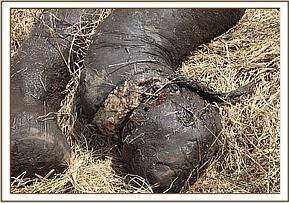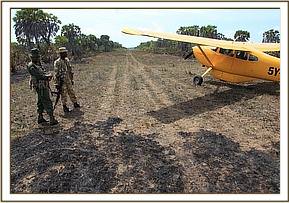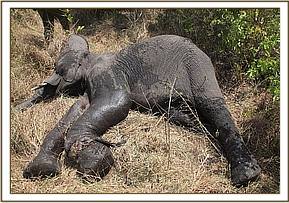Late on the 29th of March a call was received from a Kenya Forest Service (KFS) officer at Kipini Conservancy in Lamu County who had located a young bull elephant with a severe snare around its leg and requested veterinary assistance
Late on the 29th of March a call was received from a Kenya Forest Service (KFS) officer at Kipini Conservancy in Lamu County who had located a young bull elephant with a severe snare around its leg and requested veterinary assistance. With a terrible phone line it took a while to get enough information in order to plan the right response. At this stage it was essential to know the size of the elephant as this would determine whether it was necessary to send a plane to rescue it, or whether the vet needed to attend to it. Once enough information was gathered and the location certain, a plan was formed.

The first thing was to make sure the vet was available. He was asked to be on standby in the morning. In the meantime a Kenya Wildlife Service (KWS) team from Lamu was called in to keep an eye on the elephant overnight.
After verifying that the KWS team still had the elephant in sight, and after confirming the location and other logistics, early on the 31st March the DSWT Cessna 185 was airborne heading to Voi to pick the Trust funded KWS vet, Dr. Poghon, his equipment and his assistant. Flying above mounting cumulus clouds the flight took one hour.

Following recent interaction on Kipini Conservancy between the DSWT and the Kenya Forest Service, the once neglected airstrip had now been cleared and was good for landing. Once on the ground the team were met by the KWS, KFS Officer and the Kipini Conservancy Manager. The elephant was close by a short drive away standing among palms near a fresh waterhole.
The elephant was bigger and older than originally thought. With perfect timing as the vet finished preparing his dart the young bull hobbled out into the open towards the water to have a drink. Dr. Poghon was able to walk up to him quietly from behind and fire off a dart. The bull stumbled and fell in the mud, hampered by his severely damaged leg. He got up again and hobbled back to the palms, clearly in extreme pain. Shortly afterwards he fell asleep and the team are able to move in. The KWS Land Cruiser had a drum of water on board and a pipe, and immediately water was poured over him to keep him cool in the unforgiving coastal heat. The elephant’s wound was caused by a nylon rope that had plunged deeply into the young calf's ankle. After being cut and removed the wound was cleaned by the veterinary assistant, followed by a treatment of hydrogen peroxide, iodine, and antiseptic spray. Finally the wound was packed with green clay. Meanwhile Dr. Poghon had been administering long lasting antibiotics and monitoring the elephants breathing.


Thirty minutes passed and the job was efficiently done and the young calf was revived. He lay there for a minute and then attempted to rise. His body weight bearing down on his damaged front leg as he struggled to stand. He rested a while and tried again, struggling against the pain as he put pressure on his ankle. After three attempts he slowly rose and stood a while to gather his bearings. Slowly he hobbled off into the palm shade.


Over the next few days the KFS and Kipini Conservancy staff have been monitoring him. Now a few days later the elephant is growing stronger and his wound is healing making his chances of a recovery very positive whilst having fresh water and food all close by.
There are very few elephants remaining in the Lamu area. There used to be over 26,000 in the 60’s. It’s unclear how many there are today; likely not many more than 100. If this young bull survives then a precious member of the illusive elephants of Lamu will have been saved. The DSWT is also happy to have worked closely with the staff of Kenya Forest Service, Kenya Wildlife Service and the Kipini Conservancy who have all seen first-hand the damage and pain caused by a poacher’s snare. We hope this elephant not only survives, but that there has been a revived inspiration/motivation to protect this remnant herd.